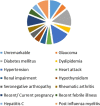Neurological complications of influenza vaccination: navigating the spectrum with a focus on acute disseminated encephalomyelitis (ADEM)
- PMID: 38333316
- PMCID: PMC10849354
- DOI: 10.1097/MS9.0000000000001656
Neurological complications of influenza vaccination: navigating the spectrum with a focus on acute disseminated encephalomyelitis (ADEM)
Abstract
Introduction: Acute disseminated encephalomyelitis (ADEM) is a rare neurological disorder characterized by inflammation in the brain and spinal cord. This systematic review aims to investigate the potential association between ADEM and influenza vaccination by analyzing relevant case reports. ADEM is traditionally thought to be a monophasic condition, predominantly affecting children, often following viral illnesses or immunizations. Recent attention has focused on a possible link between ADEM and influenza vaccination, prompting the need for a thorough investigation.
Methods: The systematic review followed the Preferred Reporting Items for Systematic Reviews and Meta-Analyses (PRISMA) guidelines and the AMSTAR2 (A MeaSurement Tool to Assess systematic Reviews 2) guidelines. Electronic searches were conducted on PubMed, Cochrane Library, and clinicaltrials.gov databases, spanning up to August 2023. Inclusion criteria encompassed full-text articles in English, observational studies, case reports, and case series providing comprehensive details for confirming clinical diagnoses of ADEM following influenza vaccination. Data were extracted, including demographic information, vaccination details, clinical symptoms, diagnostic evaluations, treatment modalities, and outcomes. Quality assessment was performed using the Joanna Briggs Institute (JBI) Critical Appraisal tool.
Results: A total of 23 cases of ADEM following influenza vaccination were identified from 19 included articles. The mean age of affected individuals was 40.2 years (±25.7) with 60.8% being male. Common presenting symptoms included muscle weakness (52.1%), urinary abnormalities (30.4%), altered consciousness (26%), and sensory disturbances (26%). Neurological examination revealed findings such as extensor plantar reflex (positive Babinski sign) in 26%, hyperreflexia in 30.4%, and generalized hyporeflexia in 13% of the cases. Diagnostic evaluations involved MRI, showing multiple hyperintense lesions in cerebral hemispheres (43.4%), subcortex (60.8%), and spinal cord (39.1%). Cerebrospinal fluid analysis indicated elevated white blood cell count in 69.5% of cases, with lymphocytic pleocytosis in 52.1%. Oligoclonal bands were reported positively in 8.6% of cases. Treatment approaches varied, with intravenous methylprednisolone being the most common (39.1%). Out of the 23 cases, two (8.6%) patients had a fatal outcome, while the rest showed clinical improvement with complete or partial resolution of symptoms. Persisting symptoms included numbness in the lower extremities (8.6%) and impaired ability to walk after 10 months (4.3%).
Conclusion: While the association between ADEM and influenza vaccination is rare, healthcare professionals should remain vigilant and consider patients' vaccination history, particularly following an influenza immunization. This systematic review highlights the clinical manifestations, diagnostic tools, treatment approaches, and outcomes of ADEM cases post-influenza vaccination. Further research is essential to understand this association and improve clinical decision-making, ensuring the safety and efficacy of immunization programs.
Keywords: acute disseminated encephalomyelitis (ADEM); central nervous system; clinical characteristics; demyelination; encephalopathy; immunization; influenza vaccine; neuroimaging; neurological disorder; vaccination adverse events.
Copyright © 2024 The Author(s). Published by Wolters Kluwer Health, Inc.
Conflict of interest statement
There are no conflicts of interest.Sponsorships or competing interests that may be relevant to content are disclosed at the end of this article.
Figures
Similar articles
-
Seropositive Neuromyelitis Optica in a Case of Undiagnosed Ankylosing Spondylitis: A Neuro-Rheumatological Conundrum.Qatar Med J. 2022 Jul 7;2022(3):29. doi: 10.5339/qmj.2022.29. eCollection 2022. Qatar Med J. 2022. PMID: 35864917 Free PMC article.
-
Acute disseminated encephalomyelitis with severe neurological outcomes following virosomal seasonal influenza vaccine.Hum Vaccin Immunother. 2014;10(7):1969-73. doi: 10.4161/hv.28961. Hum Vaccin Immunother. 2014. PMID: 25424806 Free PMC article.
-
Pediatric Acute Disseminated Encephalomyelitis Triggered by Concurrent Administration of Seasonal and H1N1 Influenza Vaccines: A Case Report and Review.NeuroSci. 2024 Dec 30;6(1):1. doi: 10.3390/neurosci6010001. NeuroSci. 2024. PMID: 39846560 Free PMC article.
-
Acute disseminated encephalomyelitis: an update.Arch Neurol. 2005 Nov;62(11):1673-80. doi: 10.1001/archneur.62.11.1673. Arch Neurol. 2005. PMID: 16286539 Review.
-
Post-COVID-19 Vaccination CNS Magnetic Resonance Imaging Findings: A Systematic Review.Can J Infect Dis Med Microbiol. 2023 Jun 29;2023:1570830. doi: 10.1155/2023/1570830. eCollection 2023. Can J Infect Dis Med Microbiol. 2023. PMID: 37427078 Free PMC article. Review.
Cited by
-
Neurological Manifestations of Influenza Vaccination: A Narrative Review.Cureus. 2025 Apr 29;17(4):e83228. doi: 10.7759/cureus.83228. eCollection 2025 Apr. Cureus. 2025. PMID: 40453260 Free PMC article. Review.
References
-
- Pohl D, Alper G, Van Haren K, et al. . Acute disseminated encephalomyelitis: updates on an inflammatory CNS syndrome. Neurology 2016;87:S38–45. - PubMed
-
- Menge T, Kieseier BC, Nessler S, et al. . Acute disseminated encephalomyelitis: an acute hit against the brain. Curr Opin Neurol 2007;20:247–54. - PubMed
-
- Cleveland Clinic . Acute Disseminated Encephalomyelitis (ADEM). Accessed September 17, 2023. https://my.clevelandclinic.org/health/diseases/14266-acute-disseminated-....
-
- Chen W-T, Huang Y-C, Peng M-C, et al. . Acute disseminated encephalomyelitis after influenza vaccination: a case report. Crit Care Nurse 2016;36:e1–6. - PubMed
Publication types
LinkOut - more resources
Full Text Sources




